| |
| Insects: butterflies and moths |
Monarch Butterfly (Danaus plexippus)
Swallowtail Butterfly (Papilio xuthus)
Blackburn’s Blue (Udara blackburni)
Large Orange Sulfur (Phoebis agarithe)
Cabbage Butterfly (Pieris rapae, aka Artogeia rapae)
Gulf Fritillary (Agraulis vanellae)
Pink-spotted Hawk Moth (Agrius cingulata)
Grey Hawk Moth (Psilogramma menephron)
Hummingbird Hawk Moth (Macroglossum pyrrhosticta)
The Black Witch (Ascalapha odorata)
Beet Webworm Moth (Spoladea recurvalis)
*Erechthias Moth (Erechthias simulans)
Bean Pod Borer (Maruca vitrata)
*Eudonia Moth (Eudonia sp.)
Autosticha Gelechid Moth (Autosticha pelodes) ?
*Grey Moth (Scopula personata) ?
Mexican Leafroller (Amorbia emigratella)
*Objurgatella Moth (Alucita objurgatella)
Green Garden Looper (Chrysodeixis eriosoma)
Banana Moth (Opogona sacchari)
Sweetpotato Vine Borer (Omphisa anastomosalis)
Lawn Armyworm (Spodoptera mauritia)
White-headed Monopis Moth (Monopis monachella)
Ereunetis Moth (Ereunetis minuscule)
Monkeypod Caterpillar Moth (Melipotis indomita)
Stultana Moth (Platynota stultana) ?
Guava Moth (Ophiusa disjungens)
*Crocidosema Moth (Crocidosema plebejana)
*Chedra Moth (Chedra microstigma)
*Silver Moth (Choropleca terpsichorella)
*Eudonia Moth (Eudonia sp.)
*Pterophorid Moth (Lantanophaga pusillidactyla)
*Copper Moth (Cryotophlebia illepida)
Tropical Meal Moth (Pyralis manihotalis)
Cotton Tipworm Moth (Crocidosema sp.)
Potato Moth (Stoeberhinus testaceus)
*Athetis Moth (Athetis thoracica)
*Small Brown Moth (Simplicia caeneusalis)
Koa Haole Moth (Macaria abydata)
*White-back Moth (Opogona perpuriella)
*Gold Body Moth (Hyposmocoma sp.)
*Hyposmocoma Moth (Hyposmocoma sp.)
*Decadarchis Moth (Decadarchis penicillata)
*Eudonia Moth (Bocana manifestalis)
Light Brown Apple Moth (Archips postvittana) ?
Tineid Moth (Decadarchis simulans)
Ilima Leafminer (Philodoria sp.)
*Fuzzy-back Moth (Hydroptila icona)
*Eupethesia Moth (Eupethesia monticolans)
*X-back Moth (Hyposmocoma sp.)
*Polydesma Moth (Polydesma boarmoides)
Cotton Looper (Anomis flava)
*Bocana Moth (Bocana manifestalis)
*Herpetogramma Moth (Herpetogramma licarcisalis)
*Eudona Moth (Eudonia micractias)
*Chionodes Moth (Chionodes discoocellella)
Tortricid Moth Caterpillar (Tortricidae sp) ?
European Corn Borer Caterpillar (Ostrinia nubilalis)
Florida Fern Moth Caterpillar (Callopistria floridensis)
Names preceded by an asterisk indicate common names that I have made up. |
Monarch Butterfly
 |
Arrived in Hawaii from North America between 1841 and 1852. It appeared in Hawaii following establishment of its primary host plant, the milkweed. |
| |
|
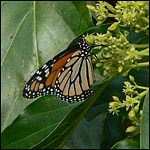 |
|
Swallowtail Butterfly
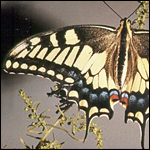 |
This butterfly naturally occurs in Asia and was first recorded in Hawaii in 1971. It is commonly seen on or near citrus trees which are its host plant. |
Blackburn’s Blue
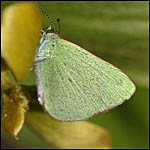 |
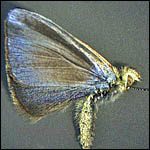 |
This is an endemic species. This is one of only two native Hawaiian butterflies. It feeds on the flowers of Acacia trees. The underside of the wings is iridescent green. |
Large Orange Sulfur
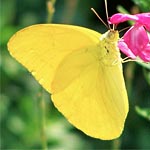 |
This species is found from Peru to US North America and now in Hawaii. So far it is found on Maui, Hawaii, and Oahu. |
Cabbage Butterfly
 |
A native of Europe reportedly arrived in Hawaii in 1897. This species is considered a serious pest for all members of the cabbage family. |
Gulf Fritillary
(aka Passion Vine Butterfly)
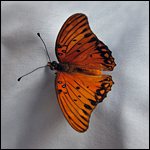 |
|
| |
|
 |
A native of the Americas from the US south to Argentina. First recorded in Hawaii in 1977, probably introduced from California. |
Pink-spotted Hawk Moth
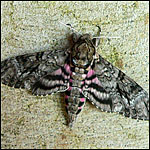 |
First recorded in Hawaii in 1877. Originally a neotropical species (but also found on Galapagos and Hawai'i) adults migrate north to Canada and south to Patagonia and the Falkland Islands. |
Grey Hawk Moth
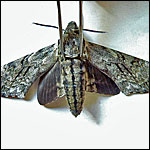 |
Originates from the Oriental and Australian regions. It is a relatively recently introduced species. |
| |
|
 |
Grey Hawk Moth caterpillar stage. |
Hummingbird Hawk Moth (aka Maile Pilau Hornworm)
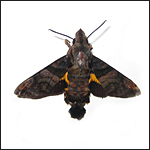 |
Wing span is about 4.5 cm. An introduced species originally from Asia. |
The Black Witch
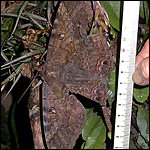 |
Male. The largest moth in Hawaii. Native to South and Central America. First recorded in Hawaii in 1928. |
| |
|
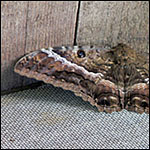 |
Female. The largest moth in Hawaii. Native to South and Central America. First recorded in Hawaii in 1928. |
Beet Webworm Moth
 |
 |
This is a non-native species. |
Erechthias Moth
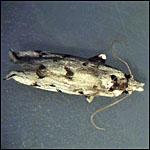 |
Dorsal view. Length = 12 mm. |
| |
|
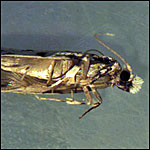 |
Ventral view. This is a species native to Hawaii. |
Bean Pod Borer
Eudonia Moth
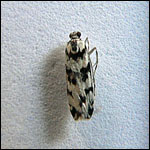 |
This is a native species. |
Autosticha Gelechid Moth
 |
This moth is 7 mm long. |
Grey Moth
 |
Body length = 8 mm.
Per Frank Howarth of the Bishop Museum “It looks like and is probably the species of Scopula that arrived in Hawaii about 2 years ago and now locally common in the lowlands. Scopula is a large genus occurring in both N. America and Eurasia. Hawaii specimens resemble S. personata (Prout) from SE U.S., but there are many look-alikes.” |
Mexican Leaf-roller
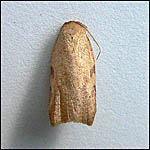 |
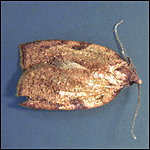 |
This moth is 1 cm long. The non-native Mexican leafroller, Amorbia emigratella, is the only known species of Amorbia in Hawaii. First discovered and described from Hawaii, but thought to be native to Mexico and Central America. |
Objurgatella Moth
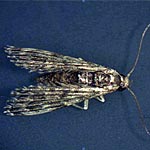 |
Per David Preston & Frank Howarth of the Bishop Museum “This is Alucita objurgatella Swezey, O.H.1927 in the Alucitidae. The larvae feed on the fruits, flowers and seeds of alahe'e, scientifically known as Psydrax odorata. The moth occurs wherever its host occurs and is considered introduced to Hawai'i though its host is indigenous. The moth could also be indigenous.” |
Green Garden Looper
 |
Moth. |
| |
|
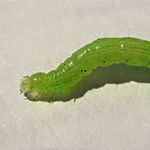 |
Caterpillar. 2 cm long.
The name "Green Garden Looper" reflects the caterpillar stage appearance. The name "Green Garden Looper" reflects the caterpillar stage appearance. The green garden looper has a widespread distribution throughout Asia, Africa, Australia, New Zealand, South Europe and the Pacific. This pest was first found in Hawaii on Oahu in 1877, and is now present on all islands. |
Banana Moth
Sweet Potato Vine Borer
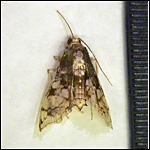 |
Dorsal view. |
| |
|
 |
Ventral view. |
Lawn Armyworm
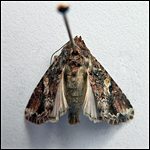 |
Body length of this moth is 1.6 cm. |
White-headed Monopis Moth
 |
Side view. |
| |
|
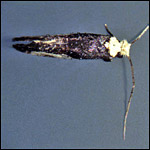 |
Dorsal view. Moth is 7 mm long. |
Ereunetis Moth
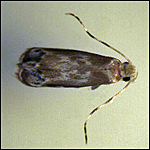 |
Dorsal view. |
| |
|
 |
Ventral view. This moth is 4 mm long. |
Monkeypod Caterpillar Moth (aka Kiawe Caterpillar Moth)
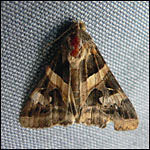 |
This moth is 2 cm long. |
Stultana Moth ?
 |
Moth is 7 mm long. |
| |
|
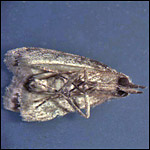 |
|
Guava Moth
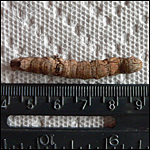 |
Per David Preston of the Bishop Museum “This is Catocalinae: Noctuidae: Ophiusa disjungens (Walker, 1858). Called the guava moth but it also feeds on other Myrtaceae including gum trees.” |
| |
|
 |
Crocidosema Moth
 |
ID by David Preston of the Bishop Museum. |
Chedra Moth
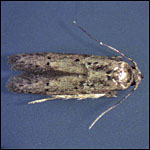 |
This moth is 6 mm long. ID by David Preston of the Bishop Museum. |
Silver Moth
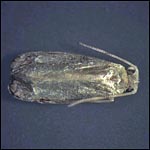 |
This moth is 4 mm long. ID by David Preston of the Bishop Museum. |
Eudonia Moth
 |
ID by David Preston of the Bishop Museum. An endemic species. |
Pterophorid Moth
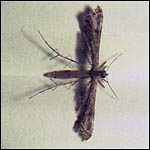 |
Body length = 5mm. ID by David Preston of the Bishop Museum. A purposely introduced species. |
Copper Moth
 |
Dorsal view, specimen 1. |
| |
|
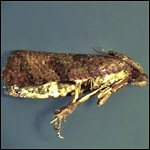 |
Side view specimen 2. This moth is about 8 mm long.
ID by David Preston of the Bishop Museum. |
Tropical Meal Moth
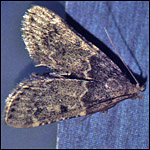 |
Moth body length = 1 cm.
ID by F.G. Howarth of the Bishop Museum. |
Cotton Tipworm Moth
 |
Dorsal view. Length = 6mm.
ID by David Preston of the Bishop Museum. |
Potato Moth
 |
ID by David Preston of the Bishop Museum. |
Athetis Moth
 |
ID by David Preston of the Bishop Museum. |
Small Brown Moth
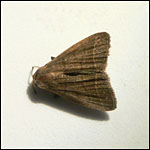 |
ID by David Preston of the Bishop Museum. |
Koa Haole Moth
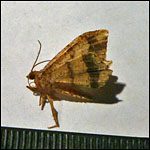 |
|
| |
|
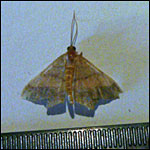 |
ID by David Preston of the Bishop Museum. |
White-back Moth
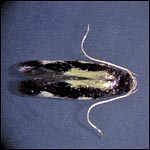 |
This moth is 6 mm long.
ID by David Preston of the Bishop Museum. |
Gold Body Moth
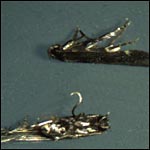 |
These moths are 3 mm long. An endemic species..
ID by David Preston of the Bishop Museum. |
Hyposmocoma Moth
 |
ID by David Preston of the Bishop Museum.
Different species from the Gold Body Moth but same genus. This is an endemic species. |
Decadarchis Moth
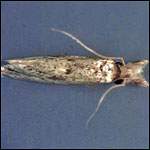 |
ID by F.G. Howarth of the Bishop Museum. |
Eudonia Moth(2)
_sm.jpg) |
ID by David Preston of the Bishop Museum. This is an endemic moth. |
Eudonia Moth(3)
_sm.jpg) |
This moth is 8 mm long. ID by David Preston of the Bishop Museum. |
Light Brown Apple Moth ?
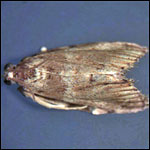 |
ID by David Preston of the Bishop Museum. |
Tineid Moth
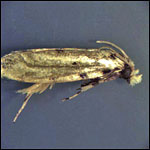 |
|
| |
|
 |
Specimen 2, close-up of head.
ID by David Preston of the Bishop Museum. |
Ilima Leafminer
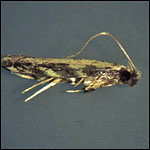 |
ID by David Preston of the Bishop Museum. This is an endemic species. |
Fuzzy-back Moth
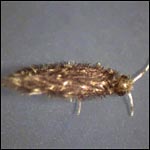 |
Dorsal view. |
| |
|
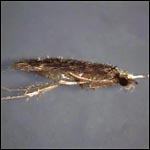 |
Side view. This moth is 3 mm long. ID by David Preston of the Bishop Museum. |
Eupethesia Moth
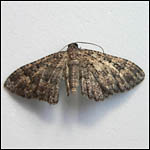 |
Wingspan 3 cm.
ID by David Preston of the Bishop Museum. |
X-back Moth
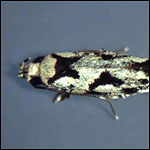 |
Dorsal view. This moth is 6 mm long. |
| |
|
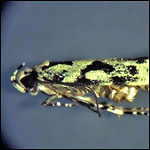 |
Closer side view.
ID by David Preston of the Bishop Museum. |
Polydesma Moth
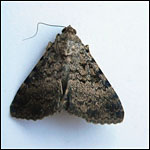 |
ID by Willian Haines of the University of Hawaii. |
Cotton Looper
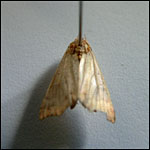 |
ID by David Preston of the Bishop Museum. |
Bocana Moth
 |
ID by William Haines of the University of Hawaii. |
Herpetogramma Moth
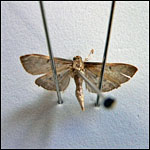 |
ID by David Preston of the Bishop Museum. |
Eudonia Moth (2)
 |
This moth is 7 mm long.
ID by David Preston of the Bishop Museum. |
Chionodes Moth
Tortricid Moth Caterpillar
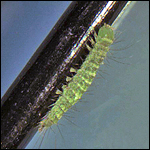 |
This green caterpillar is 9mm long. They will do the bungee-jump, i.e., drop with a silken thread, when disturbed. |
European Corn Borer Caterpillar
 |
This caterpillar is about 2 cm long and was found on an ear of “sweet Ewa corn” purchased at sustainability fair. |
Florida Fern Moth Caterpillar
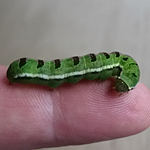 |
|
| |
|
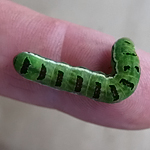 |
This caterpillar is about 3 cm long. Found on 1-6-14. |
|
|